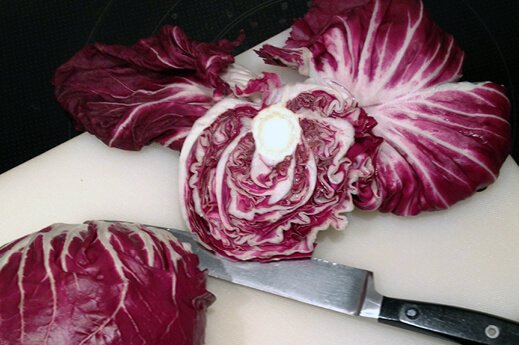The perfect balance of sweet vices
Whether to combat stress, when you are heartbroken or in the run-up to Christmas: Excessively high-sugar dietary phases can be wonderfully balanced with bitter substances.
Bitter substances are healthy. They have a positive effect on our digestive system and well-being. The bitter substances help the body to regenerate and bring the balance of acids and bases back into balance.
It is advisable to increase the number of bitter vegetables or salads on the menu, especially at times when we have nibbled too much sweets.
Whether local dandelion or endive salad, wild herbs or chicory. Bitter can taste delicious. Radicchio and artichokes are an integral part of Italian menus.
Radicchio di Treviso, the interesting dark red, elegant-looking bitter lettuce even has a European Community Protected Geographical Indication (PGI), which is given to agricultural produce that comes from a very specific place, area or landscape and where appearance, quality or other characteristics are closely linked to the geographical origin.
The champagne among salads
The Radicchio Rosso di Treviso Tardivo G.G.A. comes from 24 municipalities in the Italian region of Veneto. Among them are provinces of Venice, Padua and Treviso. The names of these regions alone make every gourmet’s heart beat faster. The hot summers, the relatively harsh winters and the abundance of water in this region fed by the Dolomites offer ideal conditions for the Radicchio di Treviso.
Interestingly, this lettuce is sown in spring and grows into a relatively large plant with green foliage in summer. The roots of the plant are dug up in autumn and stored in the dark with the addition of plenty of spring water.
In November, the shoots of the roots begin to be harvested as the wine-red Radicchio di Treviso. Calling the Radicchio di Treviso the champagne of salads is therefore not an exaggeration due to the large amount of manual work and the regional connection. In its homeland, in the hinterland of Venice, the radicchio di Treviso is processed for starters, main courses and desserts.
The interesting red color of radicchio is due to the plant pigment anthocyanin, which is also found in red wine and pomegranates. Antioxidant effects are attributed to the ability of this plant pigment to bind free radicals, and this has been the subject of numerous scientific studies.
Here are a few ideas on how to prepare radicchio di Treviso and other salads or vegetables with bitter substances:
Radicchio di Treviso in the oven with hummus with pine nuts
Radicchio di Treviso is quickest to prepare under the grill. Cut off the back end of the root, peel the stem and clean the leaves if necessary. Halve the stem of the radicchio and drizzle the two bunches of lettuce with oil and a little lemon juice and sprinkle with pepper and sea salt. Place the radicchio on a baking tray (cut side up) and put in the oven at 200 degrees (or 180 degrees fan oven). After about 10-12 minutes (depending on the size of the radicchio) the radicchio is ready.
You can use the 10 minutes in the oven to make hummus with chickpeas, tahini (sesame paste), chopped garlic, lemon juice, pine nuts, salt, pepper and oil using a food processor or “magic wand”.
Served with toasted flatbread. If you then roast 2-3 tablespoons of pine nuts (without adding fat) briefly in a small pan and then arrange the hummus, radicchio and the roasted pine nuts on the plate, you have a wonderful starter in front of you.
Chicory with goat cheese, walnuts and oranges
Most of the time is needed for the filleting of the oranges. The rest is quick:
Cut the chicory into pieces that are not too small and dissolve them with the orange pieces and a vinaigrette (sea salt, pepper, mustard – ideally a grainy French mustard – and honey in white wine vinegar and mix in the extra virgin olive oil). Topped with chunks of a lovely goat cheese and the best walnuts you can find. Finished.
Alternatively, this salad can of course also be made from radicchio leaves. As a variation, you could use a nice feta cheese instead of the goat cheese and use toasted pine nuts instead of the walnuts. The salad also works well without oranges, as not everyone likes the combination of lettuce and fruit.
Roasted radicchio with raisins and balsamic vinegar on toasted bread
Halve the radicchio leaves and fry briefly in a pan with a little olive oil, butter, pepper, sea salt and finely chopped sage leaves and deglaze with balsamic vinegar. If you like, you can add raisins and
let them stew briefly.
Toast a nice rye bread and spread it with honey. Then the radicchio comes out of the pan. The radicchio breads go perfectly with a chilled Riesling or Sauvignon Blanc. Also a nice starter if you are expecting guests.
Dandelion with potatoes as an accompaniment to steamed fish
Leave small bacon cubes in the pan, deglaze with white wine vinegar and briefly mix in the finely chopped stems and leaves of the dandelion. The still warm dandelion goes perfectly with potatoes. Depending on your preference, you can dip the pan-warm dandelion into mashed potatoes or mix the dandelion with boiled potatoes that you have cut into cubes.
The bitter taste of dandelions (you can often find dandelions on the market from organic farmers) combined with potatoes makes a wonderful accompaniment to steamed fish fillets.
Chicory salad with avocado and shrimp
You need most of the time for chopping lettuce and side dishes with spices. The advantage: once you have completed these preparations, you can prepare the salad well, then prepare it à la minute and then relax and devote yourself to your guests.
It is best to start by chopping the shallots, ginger, a small piece of a chilli and garlic. (As a GloriousMe reader, you already know how healthy this dish is going to be.)
Next, you can clean the chicory salad and cut into pieces. Fry the shrimps in rapeseed oil in a pan, add sea salt, pepper and the previously chopped spices, simmer briefly and deglaze with Noilly Prat.
Now lift the avocado out of the shell, cut into pieces and immediately sprinkle with lemon juice to prevent the avocado from turning brown. Mix the avocado with the chicory salad and arrange on the plate. Arrange the shrimp from the pan on top.
Bitter salads with a lukewarm anchovy vinaigrette
This is how people love bitter salads in northern Italy: whatever bitter salads you have in the vegetable drawer or in the garden, chicory, radicchio, endive, dandelion, sorrel. Here it can be a colorful mix of these types of lettuce that you wash and cut into small pieces.
Make the vinaigrette with the usual ingredients, but use less olive oil than usual. Remove small anchovy fillets from the jar, remove the salt and/or oil used to marinate the anchovy fillets and cut the anchovy fillets into very small pieces. Heat this in a small saucepan and add the vinaigrette to warm the mixture slightly.
The word light is essential here, because the vinaigrette should not be overheated. Mix the heated anchovy vinaigrette mixture lukewarm with the chopped bitter lettuce and serve immediately. In addition, an excellent sourdough bread, salted butter and a nice glass of Chianti, Primitivo or Barbera. Buon appetito!
Since the combination of bitter vegetables and salads is very appreciated in Italy, some of the recipes provide for the use of anchovy fillets. A little tip from the GloriousMe kitchen: We have tried many brands over the past few years. We like the anchovy fillets from Ortiz best. A quality product that has never disappointed us and that tastes so good that you can simply enjoy the anchovy fillets on a good piece of buttered bread.
Endive salad with toasted almonds topped with an egg and caper mixture
In the past, endive was always trusted to taste bitter. Nowadays you don’t always get a breed in which bitter substances have been left. If you are lucky enough to get an endive salad that still tastes bitter, prepare it with a vinaigrette and mix in peeled almonds that you have pan-roasted until golden brown and seasoned with sea salt.
On top of the finished salad, place a mixture of hard-boiled eggs cut into small pieces, capers, finely chopped anchovy fillets, and some crème fraiche mixed with a nice tarragon mustard. Lovers of mayonnaise are of course welcome to replace the créme fraiche with a light lemon mayonnaise.
No time
You find the recipes interesting, but don’t have time to cook at the moment? Then open a jar of pickled artichoke hearts and serve them with the aperitif. Artichokes are a wonderful vegetable and who hasn’t photographed the beautiful artichoke blossoms on the loading area of an artichoke farmer while on holiday in Italy? The preparation requires some technical tips, so we will soon devote a separate chapter to this vegetable.
It would be a shame
You’ve probably already noticed that there are bitter vegetables in the supermarket and at the greengrocer’s
and salads increasingly difficult to find. Many a greengrocer shakes his head sadly when asked about it and says, “People don’t like that anymore. The newly bred varieties are increasingly doing without the bitter taste”. It would be a great pity if the bitter vegetables or the bitter part in vegetables or salads gradually disappeared.
Just remember to state your desire for bitter substances in salads and vegetables during the next survey in the supermarket, so that not only the shelf layout is optimized, but also the healthy range of bitter vegetables and salads is retained. And encourage your greengrocer by not leaving the bitter varieties lying around, but by buying them and enjoying them!
If you also have a favorite recipe with salads or vegetables that contain a lot of bitter substances, write to us. We like to try it.
#Advertising #Product Placement #IndependentGMRecommendation #BecauseWeLoveIt




